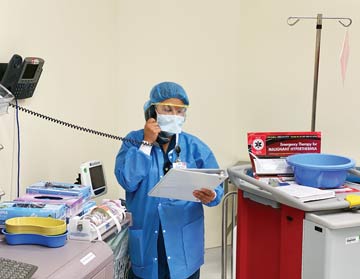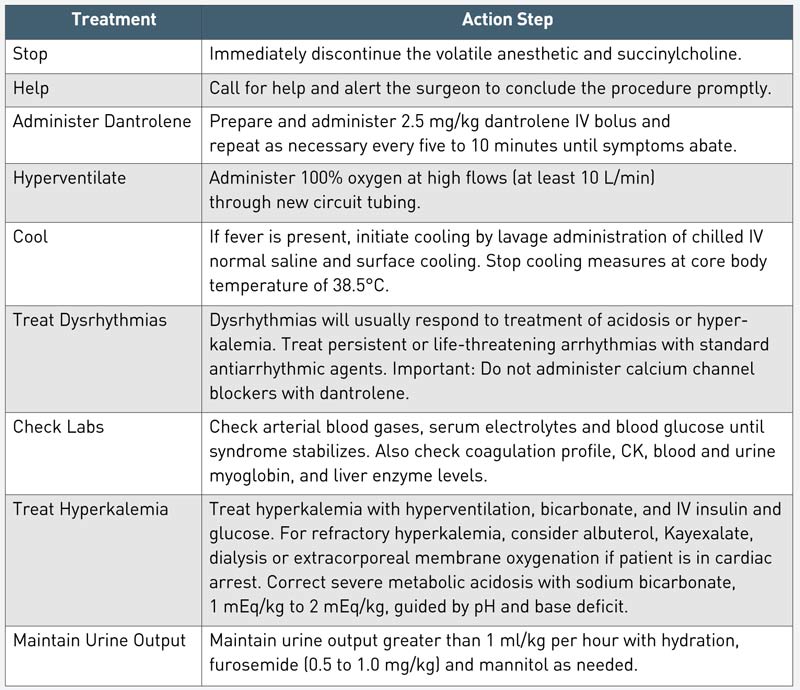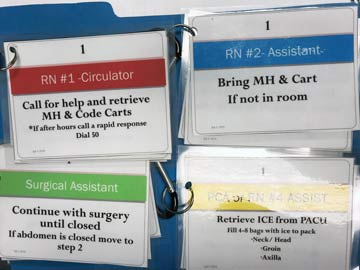Many surgical professionals learn best by doing. If you bombard them with information about what to do in the event of a malignant hyperthermia (MH) emergency, but don't give them a chance to physically go over the many critical steps they need to take, chances are they won't be fully prepared when a real crisis hits. MH might be rare, but its related complications are serious, so engaging and easy-to-retain simulation training is a must.
- Home
- The Magazine
- Article
Always Prepared for MH
By: Jasmine Hampton
Published: 12/10/2020
Interactive drills and clearly defined roles ensure staff are ready for a real-life emergency.
1. Create realistic scenarios
While planning our facility's MH training program, I told Rob Simon, CRNA, our facility's chief nurse anesthetist, to make sure staff didn't spend 40 minutes sitting around listening to a lecture they'd likely forget right after it ended. That's all Rob, a skilled clinician who also serves as a professor at a local university, needed to hear.
He created three real-life patient scenarios to guide our education and training efforts. If you're creating scenarios, you want to be as specific as possible. For instance, one of the scenarios dealt with a patient whose MH symptoms came on in the PACU — something that can occur, but is often overlooked during training. With this type of scenario, you want to teach staff how to spot the early physical symptoms — such as muscle rigidity — that present when there's no end-tidal CO2 monitoring to reference.
2. Spell out action steps
There are specific ways staff members must respond to the first signs of MH. We wanted response protocols to be as clear and concise as possible for our OR team, so Rob created a bulleted, step-by-step review guide of every critical action necessary to resolve a crisis based on information from the Malignant Hyperthermia Association of the United States (mhaus.org). The guide needs to cover everything your staff needs to do without confusing them in the process (see the sidebar below). For instance:
Stop: Immediately discontinue the volatile anesthetic and succinylcholine.
Help: Call for help and alert the surgeon to conclude the procedure promptly.
Administer Dantrolene: Prepare and administer 2.5 mg/kg dantrolene IV bolus and repeat as necessary every five to 10 minutes until symptoms abate.

We created a quick-reference guide to direct our staff's MH response by breaking down each treatment step, starting with stopping the use of the triggering agent and ending with ensuring the patient maintains urine output, into broad actions. Download a copy of the form at outpatientsurgery.net/forms.

In addition to the step-by-step treatment guide, we created and reviewed individual role cards, which are color-coded according to clinical role and spell out exactly what each member of the response team is supposed to do during an MH event.
Creating role cards and keeping them with your MH cart is a safeguard against confusion and missed steps. The reality of MH training is that you can never be 100% ready when it strikes. It's so rare that my own clinical manager hasn't faced an event since her sole MH experience 38 years ago. You can drill your staff every six weeks like clockwork, but when it comes to the heat of the moment, they could freeze under the pressure if they've never experienced the situation with an actual patient. That's the beauty of having role cards to reference when seconds count. Even if your staff has the response process memorized, the cards give them added peace of mind and help them stay calm during a high-stress situation.
3. Practice with purpose

Even the best educational materials are destined to fall flat if you don't make the training engaging and interactive. That's where our MH drill comes into play. After Rob reviews all of the treatment steps, our staff breaks into groups. Then, they're given a scenario and a set amount of time to list all the treatment steps they should take to resolve the situation. On top of ensuring the treatment steps stick, this approach fosters team building, organization (each team selects a scribe to write down all of the steps) and a healthy dose of competition. To raise the stakes, the team that lists all the steps in the correct order wins a small prize.
In addition to the team-based competition review, we simulated what is arguably the most vital part of resolving an MH crisis: administering dantrolene. I obtained expired vials of dantrolene from our pharmacy and asked staff to volunteer for a reconstituting race. A few staff members stepped up and competed to see who could correctly mix the dantrolene the fastest, and we awarded a small prize to the winner.
Simulation training is the perfect way to highlight the difference between understanding the steps you're supposed to take during an emergency and physically doing them. The dantrolene-mixing process was more challenging than any of the volunteers expected, and they were only mixing a fraction of the dantrolene they'd need during a real MH crisis. After they finished the simulation, I said, "If you thought that was tough, you'd need the amount you mixed times 20 during a real emergency." That really drove home the importance of using simulation training.
We haven't experienced an MH event since overhauling our training program, but we recently discovered during a routine pre-op assessment that a patient had risk factors for MH. I had the opportunity to alert the surgical team, review how they should respond to a crisis and roll the MH cart to just outside the OR door. Fortunately, the patient got through surgery without incident, but watching the way our staff conducted themselves as soon as they were alerted to the situation told me everything I needed to know about how they would handle a real-life emergency. The effort we put into making our MH training an engaging and hands-on experience ensures every member of our surgical staff is fully prepared to respond to a crisis correctly and confidently. OSM
.svg?sfvrsn=be606e78_3)
.svg?sfvrsn=56b2f850_5)